The Mysterious Sjogren’s Syndrome

If you are a female and seem to have a very dry mouth and dry eyes all the time, you may be suffering from a chronic syndrome that is all too common. For some reason, many primary care practitioners overlook these symptoms in many people and simply treat the complaint directly. For that reason I have entitled this posting, “The Mysterious Sjogren’s Syndrome (SS).”
I am an Internist by training (who practiced chronic pain management) and had several women with SS whom had gone undiagnosed for years prior to coming to my practice. By the time people were referred to me they had usually had all the common causes for their pain ruled out. It gave me an advantage.

Patients often asked me why the other Doctors they had seen could not diagnose them and that I seemed to make the diagnosis rather easily. I had to confess to them that the other Doctors had done all the hard work so that I only had to consider the rare and unusual syndromes. It certainly wasn’t because I was some genius:)
Chronic symptoms that are diffuse in nature are usually due to a generalized process of some sort. When 2 or more body systems are affected by anything I was prone to look at a patient’s immune system as the culprit. Disorders of the immune system are usually “systemic” and can affect nearly any organ of the body.
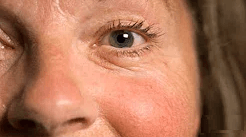
Some immune disorders are very aggressive and cause widespread damage very quickly (such as Rheumatoid Arthritis). However, the majority of these mysterious disorders are more chronic and annoying to the patient.
These less toxic forms of immune disorders often manifest with vague, non-specific symptoms such as fatigue, joint aches, mental cloudiness, dry mouth, etc. The symptoms often give little clue to the exact cause of the disorder (other than to alert a patient all is not well). They can go undiagnosed for years because of this.

Furthermore, the diagnosis is often made with very specialized blood tests, unique and uncommon diagnostic testing, and reveal normal initial screening tests. So it is with Sjogren’s Syndrome (SS). You have to think of it as a diagnostic possibility before the proper tests are ordered. Hopefully, this post will help others to think of SS when the combination of dry eyes, dry mouth, joint pain, and fatigue manifest in a female patient.
SS is a common immune related disease. It occurs in up to 4 million Americans. It is estimated that 1.4% of the female American population is affected by the disorder. If you are in the practice of medicine, you are likely to have several patients with the disorder. You need to look for it.
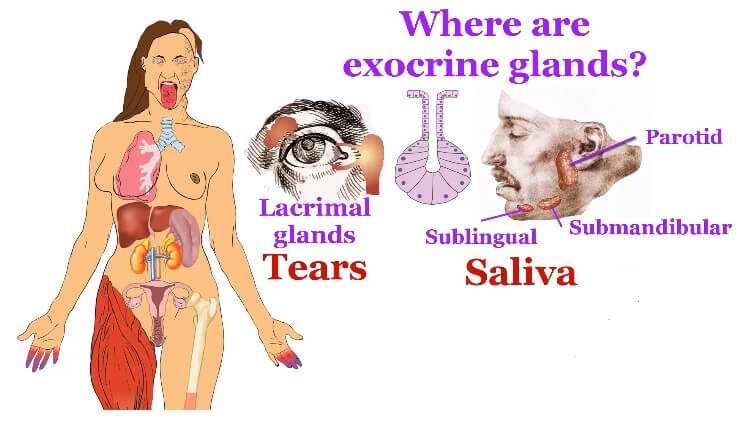
If you are a female, you are likely to know someone who has the disorder (if not yourself). This disorder is not rare and should be in the “Top 10” considerations of anyone with vague multi-system complaints.
The Symptoms Of Sjogren’s Syndrome (SS)
SS effects areas of the body that require secretion of fluid for proper functioning. That means, any area of the body such as the eyes, mouth, joints, skin, and vagina are potential targets of SS. The eye symptoms may first present as a conjunctivitis (redness, irritation, “gritty” feeling of the eyes) and be misdiagnosed as an infection.
To make things even more challenging for your Doctor, the eye symptoms may be the only initial symptoms of SS (preceding the dry mouth by weeks or months). One clue to SS is that the conjunctivitis that occurs will not be associated with an abundant discharge (which is more common with infectious causes of conjunctivitis).

Mouth dryness may be initially relieved with the frequent drinking of water. However, if the process goes on untreated, dental decay, mouth ulceration, and loss of teeth can actually occur. The production of saliva is necessary for good mouth health and the preservation of one’s teeth.
Because SS is a “systemic disorder,” a wide range of organ systems can become involved by the disease process.
The following is a partial list of the potential organ involvement with SS:
- Arthralgia (simple joint pain) or Arthritis
- Vaginitis (resulting in painful intercourse)
- Hashimoto’s thyroiditis (an inflammation of the thyroid gland in the neck)
- Parotid gland enlargement (a swelling of the salivary glands on the sides of the face…looking similar to mumps)
- Lung involvement (there are several syndromes that develop in the lung: interstitial lung disease (ILD) and small airway abnormalities)
- Peripheral neuropathy (a burning type of pain)
- Lymph node enlargement
- Vasculitis (inflammation of blood vessels…usually arteries)
- Raynauld’s phenomenon (hands may discolor and hurt when exposed to the cold)
- Gastritis (pain and inflammation of the stomach)
- Esophagitis
- Pancreatitis
- Lymphoma (a particular type of cancer of the lymph nodes)
- Hepatitis
- Cirrhosis
- Cystitis (painful, frequent urination)
- Kidney involvement
The more serious complications of SS occur the longer the syndrome goes untreated. For instance, lung involvement, parotid gland involvement, and neuropathy occur more commonly in people who have had the disease for more than 10 years.
The Diagnosis Of Sjogren’s Syndrome
Sjogren’s Syndrome is divided into Primary SS and Secondary SS (when SS occurs in the presence of another pre-existing immune disease). The criteria are as follows:
For primary SS:
- Patients need to satisfy four of six criteria with at least one criterion being the presence of sialadentitis on lip biopsy or anti-SSA or anti-SSB. Other diseases including hepatitis B or C, HIV infection, sarcoidosis and history of radiation should be excluded
- The presence of any three of the four objective criteria items (3, 4, 5, 6)
For secondary SS:
- It is diagnosed when the patient has either item 1 or 2 plus any two among items 3, 4, 5 (in the presence of another immune mediated disease):
The diagnostic criteria are as follows:
1)Ocular symptoms (> 3 months)
2)Oral symptoms (> 3 months)
3)Ocular sign (Schimer’s test ≤ 5 mm/5 min, Rose Bengal Score ≥4)
4)Minor salivary gland biopsy (≥ 1 focus of lymphocyte infiltration)
5)Salivary gland involvement (one of the following being positive):
-Salivary scintigraphy (specialized radionuclear study of the salivary glands – non-invasive)
-Parotid sialography (specialized radiographic study using contrast – invasive)
-Unstimulated salivary blow, < 1.5 ml/15 min (measurement of saliva production over 15 minutes)
6)Autoantibodies (either Anti-SSA or anti-SSB positive taken by performing a simple blood test)
The Treatment Of Sjogren’s Syndrome
The treatment of the actual disease process in SS, with immune modulating substances, has remained elusive. Several promising studies are underway with B cell modulating medications (the B cell is a type of lymphocyte). The actual immune process in SS involves the B cell so it would make sense for medications that target this sub-type of lymphocyte to show promise for slowing down the actual disease process.
Use of immune mediating substances is primarily reserved for severe systemic organ system involvement in SS. As previously stated, the effectiveness of these treatments has been inconsistent and incomplete.
Treatment of SS is primarily directed at the dry mouth and dry eyes disease symptoms. The following table reviews these treatments:
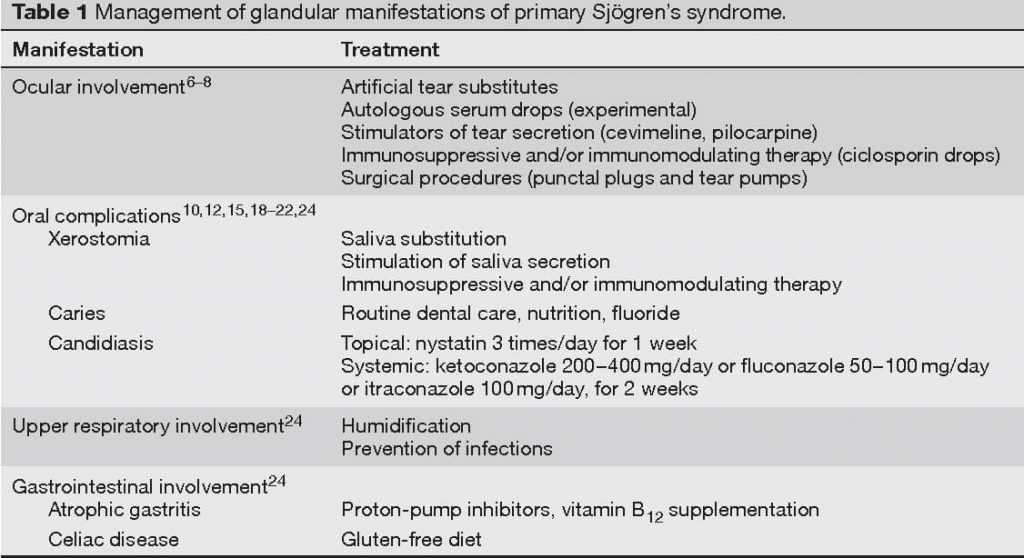
Summary
I have reviewed the epidemiology of SS along with the various organ system involvement, diagnostic criteria, and treatments. Though there is no formal cure as yet, research is ongoing.
The symptoms of dry eyes and dry mouth are very well treated as enumerated above. It is only a matter of time before a reliable treatment that modifies the actual disease process is developed.
The aforementioned review of Sjogren’s Syndrome is not to be considered medical advice but is informational only. As always, I recommend a thorough history, physical, and medical management of your case be supervised by a licensed medical practitioner.
I hope you have enjoyed this monograph on SS. If you have any further questions, please comment. I would love to hear from you and will promptly answer you.
Wishing you joy and healing,




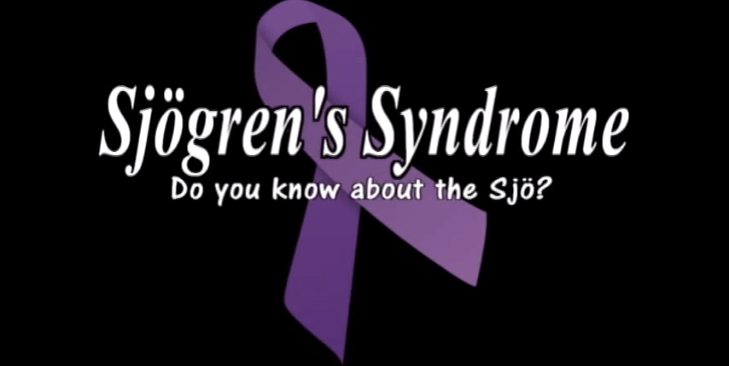
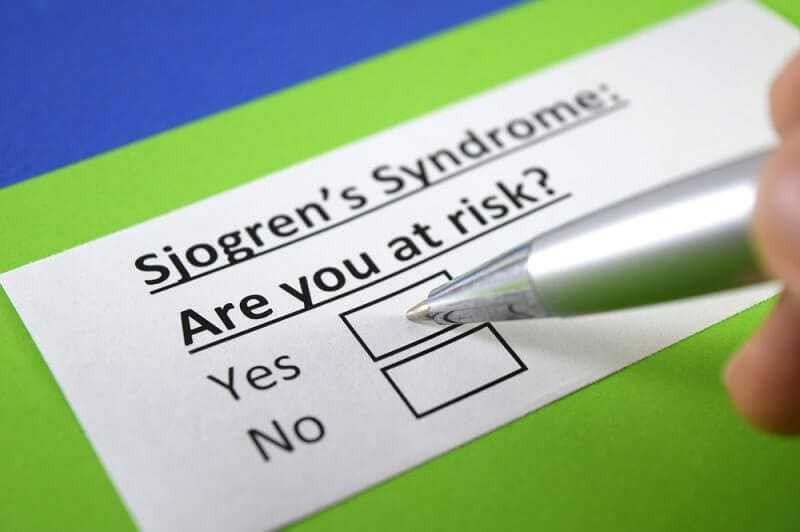
I hear so much about “treatment” of Sjogren’s Syndrome which as you say is usually aimed at symptoms. I like to think of supporting body systems to aid in their working more normally. I found great improvement in my dry eyes with regular Fish Oil supplements and an eye lid wash. I’ve found homeopathic remedies to eliminate mouth and lip sores after I’ve eaten too much high acid foods. I’m trying alkaline water now. Essential oils greatly assist my sinuses in draining properly. I use a commercial combo of eucalyptus, peppermint, rosemary, frankincense and thyme And when congestion is deep, golden seal does the trick. For joint pain I use white willow bark. I have no side effects from these. Also, Vitamin D has helped counteract my fatigue. Until we do figure out these myriad inflammatory conditions and have actual treatments, let’s focus on improving health.